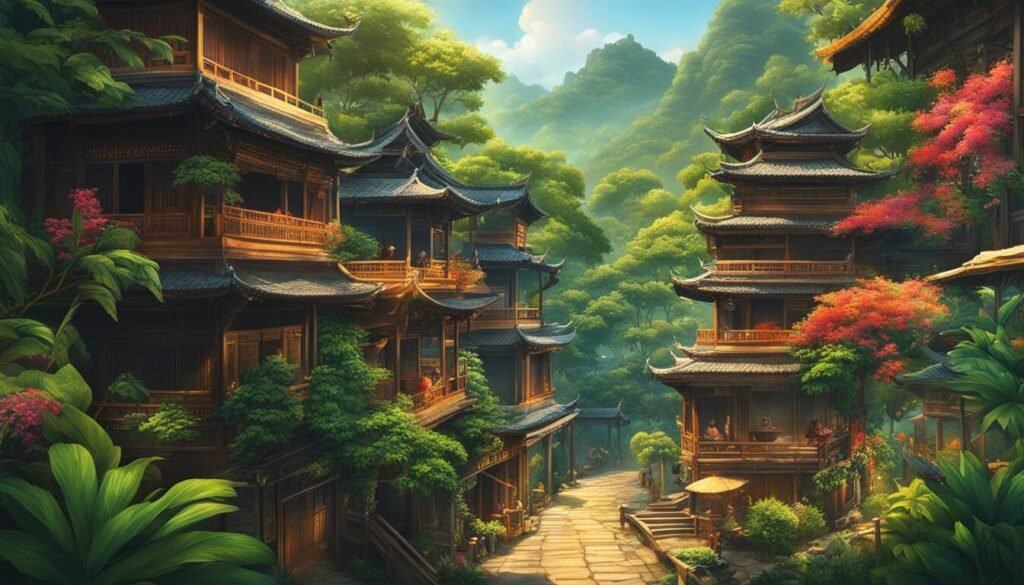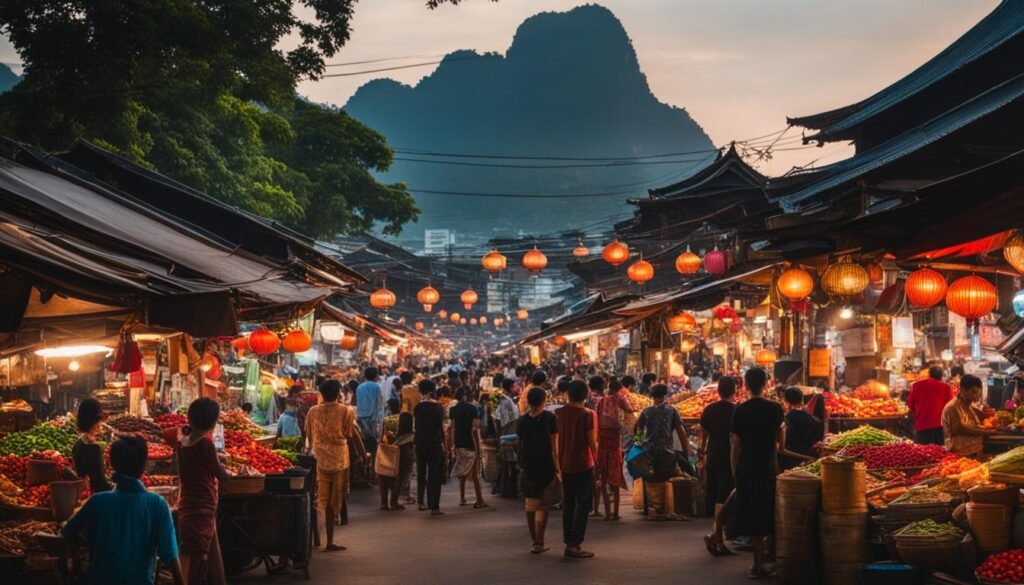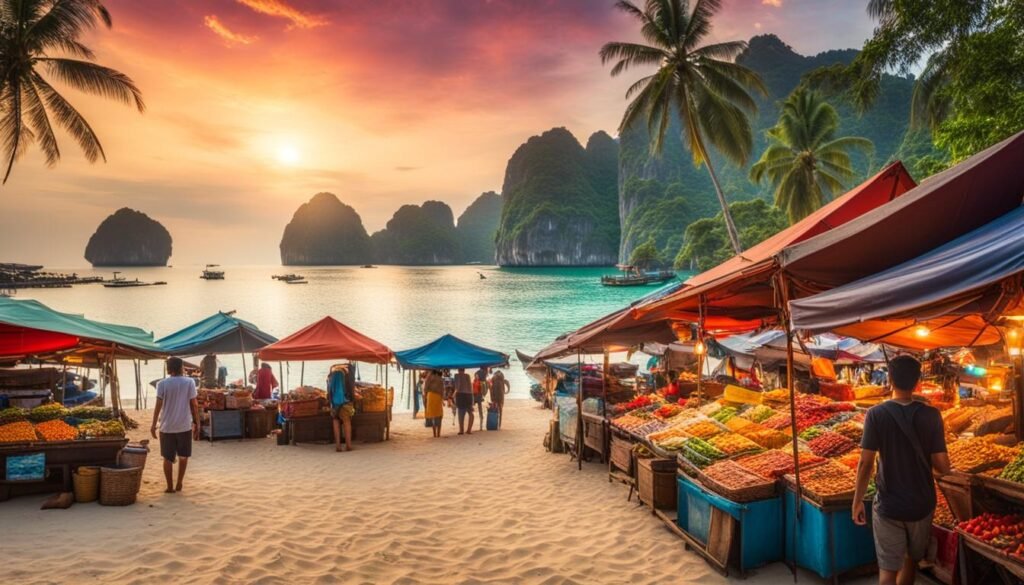South East Asia is a region with a rich and diverse history, made up of a collection of countries that offer unique cultural experiences and breathtaking landscapes. If you’re planning a trip to this fascinating part of the world, it’s essential to know what countries are in South East Asia so you can begin your travel planning.
Some of the most popular Southeast Asian countries include Thailand, Vietnam, Indonesia, Malaysia, and the Philippines. But there are other lesser-known nations waiting to be explored, such as Cambodia, Laos, Brunei, Myanmar, and Singapore.
Each of these countries has its distinct culture, traditions, and history that are reflected in their architecture, cuisine, and customs. You can witness the colorful celebrations, mouth-watering street food, and awe-inspiring historical sites that make South East Asia such a captivating region to explore.
As you journey through these countries, you’ll find yourself immersed in a world of diversity, from the bustling metropolises like Bangkok and Manila to the tranquil countryside of Laos and Vietnam. Whether you’re trekking through the lush jungles of Indonesia or soaking up the sun on one of Thailand’s pristine beaches, you’ll be surrounded by breathtaking natural beauty that sets the region apart.
Key Takeaways
- South East Asia is made up of a collection of diverse countries with distinct cultures and traditions.
- Some of the most popular Southeast Asian countries include Thailand, Vietnam, Indonesia, Malaysia, and the Philippines.
- There are lesser-known nations waiting to be explored, such as Cambodia, Laos, Brunei, Myanmar, and Singapore.
- The region boasts breathtaking natural beauty, from lush jungles to pristine beaches.
- Exploring South East Asia is an opportunity to immerse yourself in a world of diversity.
Southeast Asia: A Melting Pot of Cultures
When it comes to countries in Southeast Asia, you’ll find a wide range of cultures and traditions that are unique to each nation. From the bustling cities of Singapore and Kuala Lumpur to the tranquil temples of Cambodia and Laos, the region is a melting pot of diverse customs and practices.
With more than 11 countries located in Southeast Asia, each nation boasts its own set of languages, religions, and cultural practices. These differences are what make the region so intriguing and worth exploring.
The List of Southeast Asian Countries
If you’re curious about the countries located in Southeast Asia, check out this list:
| Country | Capital |
|---|---|
| Brunei | Bandar Seri Begawan |
| Cambodia | Phnom Penh |
| Indonesia | Jakarta |
| Laos | Vientiane |
| Malaysia | Kuala Lumpur |
| Myanmar (Burma) | Naypyidaw |
| Philippines | Manila |
| Singapore | Singapore |
| Thailand | Bangkok |
| Timor-Leste (East Timor) | Dili |
| Vietnam | Hanoi |
As you can see, the region boasts a diverse set of nations, each with its own unique cultural identity and history.
Exploring the Cultures of Southeast Asia
One of the most intriguing aspects of Southeast Asia is the myriad of cultures that can be found throughout the region. From the ancient temples of Cambodia to the bustling night markets of Thailand, each country boasts its own set of customs and traditions.
You’ll also find a variety of religions, including Buddhism, Islam, Christianity, and Hinduism, each playing a significant role in shaping the cultural fabric of the region.
Some of the standout cultures in Southeast Asia include:
- The Javanese culture of Indonesia, known for its intricate batik textiles and gamelan music.
- The cuisine of Thailand, which is known for its bold flavors and use of fresh herbs and spices.
- The Khmer culture of Cambodia, which is celebrated for its elaborate temple architecture and traditional Apsara dance performances.
Overall, if you’re looking to immerse yourself in a diverse range of cultures, Southeast Asia is an excellent place to start.
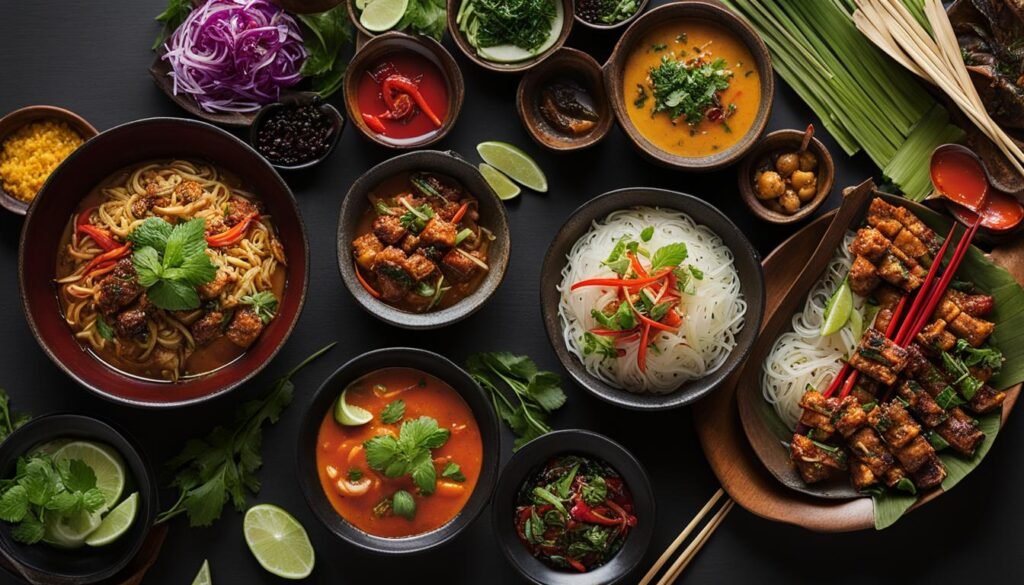
Exploring the Diverse Landscapes of South East Asia
South East Asia boasts a stunning array of landscapes, from dense rainforests to bustling cities. The region is made up of 11 nations, each with its own unique geography, topography, and natural wonders.
Mountains and Highlands
Southeast Asia is home to several mountain ranges, including the Himalayas, which run through Nepal, Bhutan, and the northern parts of India. The Annamite range spans across Vietnam, Laos, and Cambodia and is home to several national parks, where you can explore scenic trails and marvel at waterfalls and wildlife. The Malayan mountain range stretches from Thailand to Malaysia and is known for its stunning tea plantations, cool hill stations, and tropical forests.
Coastlines and Islands
With miles of pristine beaches and crystal-clear waters, South East Asia is a paradise for beach lovers. Thailand’s Phuket and Indonesia’s Bali are two of the most popular destinations, offering stunning white sand beaches that stretch for miles. The Philippines is home to over 7,000 islands, each with its own unique charm, from the towering cliffs of Palawan to the vibrant coral reefs of Boracay.

Forests and Jungles
The region is home to some of the world’s most diverse rainforests, including Indonesia’s Borneo rainforest and the renowned Amazon Rainforest, which spans across eight countries, including Peru, Brazil, and Colombia. These lush rainforests are home to rare and exotic animal species, such as orangutans, tigers, and giant pandas. The region also boasts several national parks, such as Thailand’s Khao Yai National Park and Singapore’s Bukit Timah Nature Reserve, where you can trek through scenic trails and explore the local flora and fauna.
Rivers and Deltas
The mighty Mekong River runs through six Southeast Asian countries, including China, Laos, Cambodia, Thailand, Vietnam, and Myanmar. The river is a vital source of livelihood for local communities and supports a diverse ecosystem of plants and animals. The Mekong delta in Vietnam is known for its scenic boat rides, floating markets, and rice paddies.
From majestic mountains to pristine beaches, Southeast Asia is a diverse and breathtaking region that offers a wealth of natural and cultural attractions. Whether you’re an adventure seeker, a nature lover, or a beach bum, you’re sure to find something that captivates your imagination in this enchanting part of the world.
The Member Nations of ASEAN
If you’re interested in Southeast Asia, you may have heard of ASEAN. The Association of Southeast Asian Nations (ASEAN) was formed in 1967 and currently includes 10 member countries. These nations work together to promote economic growth, social progress, and cultural development in the region.
The ASEAN member countries are:
| Country | Capital | Population |
|---|---|---|
| Brunei | Bandar Seri Begawan | 459,500 |
| Cambodia | Phnom Penh | 16.4 million |
| Indonesia | Jakarta | 270.6 million |
| Laos | Vientiane | 7.2 million |
| Malaysia | Kuala Lumpur | 31.6 million |
| Myanmar | Naypyidaw | 54 million |
| Philippines | Manila | 108.1 million |
| Singapore | Singapore | 5.7 million |
| Thailand | Bangkok | 69.4 million |
| Vietnam | Hanoi | 96.5 million |
The ASEAN member countries are a diverse group with different political systems, religions, and cultures. Despite these differences, they come together to work towards common goals and promote regional cooperation.
Membership in ASEAN provides these countries with economic benefits and helps to strengthen international relations. It also allows them to work together on issues such as climate change, terrorism, and human rights.
Overall, the member nations of ASEAN play an important role in the dynamic and diverse region of Southeast Asia.
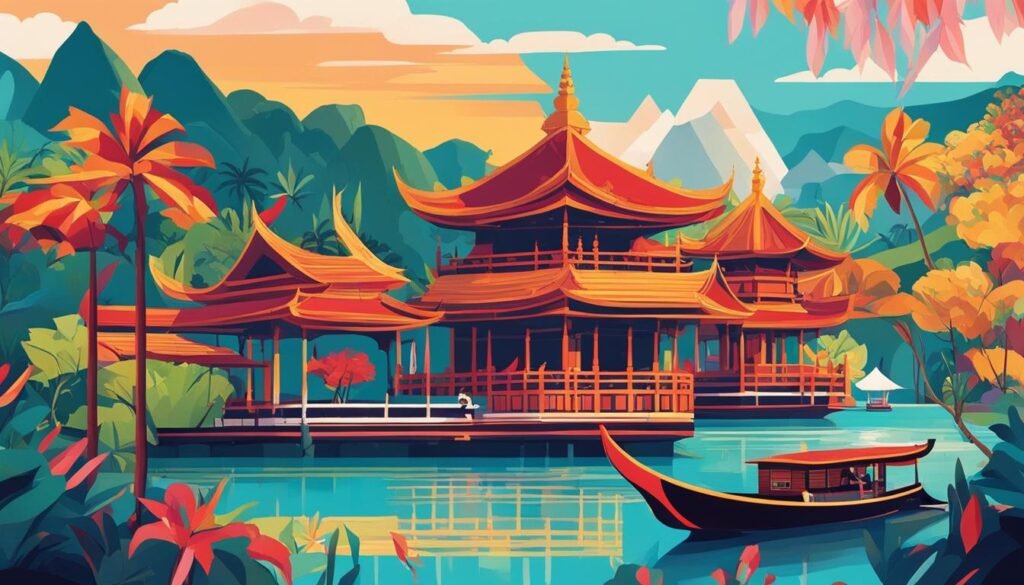
Indonesia: The Archipelago Nation
Indonesia, the largest country in South East Asia, is a sprawling archipelago made up of more than 17,000 islands, each with its unique culture, language, and traditions. Its diverse landscape ranges from the bustling capital city of Jakarta to the pristine beaches of Bali and the Komodo National Park, home to the iconic Komodo dragon.
The country is also home to a rich cultural heritage, with a history that can be traced back to ancient kingdoms and empires. Today, Indonesia is a vibrant melting pot of different ethnic groups, each with its customs and traditions.
“Indonesia is a beautiful country, with so much to offer. From the stunning natural beauty of its landscapes to the warmth and hospitality of its people, there is something truly special about this place.”
While Bali is perhaps the most well-known destination in Indonesia, there is so much more to explore. Java, the country’s most populous island, is home to the capital city of Jakarta and the ancient temples of Borobudur and Prambanan. Sumatra, the sixth-largest island in the world, is a nature lover’s paradise, with rainforests, waterfalls, and diverse wildlife.
No matter where you go in Indonesia, you’re sure to be struck by the country’s warm and welcoming culture. From the traditional dance performances to the delicious local cuisine, there is so much to discover and explore.

Indonesia at a Glance
| Capital | Jakarta |
|---|---|
| Largest city | Jakarta |
| Population | 273 million (2021) |
| Ethnic Groups | Javanese, Sundanese, Malay, Chinese, and others |
| Languages | Bahasa Indonesia (official), Javanese, Sundanese, and others |
| Currency | Indonesian Rupiah (IDR) |
Thailand: The Land of Smiles
If you’re looking for a destination that offers a mix of unique cultural experiences, stunning natural scenery, and delicious cuisine, look no further than Thailand. This southeast Asian country is known as the “land of smiles” thanks to the friendly and welcoming nature of its people, who make visitors feel right at home from the moment they arrive.
The Vibrant Cities
Thailand’s cities are a fascinating blend of old and new, with ancient temples and modern skyscrapers standing side-by-side. Bangkok, the capital city, is a bustling metropolis that is home to some of the country’s most iconic sights, including the Grand Palace and Wat Arun temple. Chiang Mai, in the north of the country, is known for its relaxed atmosphere and beautiful temples, while the beachside town of Phuket offers a perfect mix of sun, sand, and sea.
The Ancient Temples
Thailand is home to thousands of Buddhist temples, each with its own unique history and architecture. The most famous of these is Wat Phra Kaew in Bangkok, which houses the iconic Emerald Buddha statue. Other notable temples include the ancient ruins of Ayutthaya and the intricate carvings of Wat Rong Khun.
The Delicious Cuisine
Thai food is famous around the world for its bold flavors and unique combinations of sweet, sour, spicy, and salty. Whether you’re enjoying a street food snack like pad thai or indulging in a full sit-down meal, you’re sure to find something to tempt your taste buds. Don’t miss out on trying some of the country’s most popular dishes, such as green curry, tom yum soup, and mango sticky rice.

“The people of Thailand are warm and welcoming, and their rich culture and history make it a truly unique destination to explore.”
Vietnam: A Tapestry of History and Tradition
Vietnam is a country located in the eastern part of the Indochinese Peninsula and has a unique blend of cultural traditions and modern developments. With a rich history dating back to ancient dynasties and French colonial influence, Vietnam is a tapestry of history and tradition.
The History of Vietnam
Vietnam has a long and complex history, with a timeline that spans over 4,000 years. The first Vietnamese state was established in 2879 BC and since then, the country has been ruled by various Chinese dynasties, French colonial powers, and even the United States during the Vietnam War.
Despite this tumultuous past, Vietnam has managed to preserve its cultural heritage and maintain a strong sense of national identity. Today, the country is known for its distinct cuisine, music, and art, all of which are influenced by its long and rich history.
The Culture of Vietnam
Vietnamese culture is heavily influenced by Confucianism, Buddhism, and Taoism, all of which emphasize respect for authority and tradition. This can be seen in the way that Vietnamese people interact with each other, with an emphasis on family values and social harmony.
One of the most iconic aspects of Vietnamese culture is its cuisine, which is known for its bold flavors and fresh ingredients. Traditional dishes like pho and banh mi have gained widespread popularity around the globe.
Traveling to Vietnam
If you’re planning a trip to Vietnam, there are plenty of sights and attractions to explore. The country’s capital, Hanoi, is a bustling city that offers a mix of old-world charm and modern conveniences. Meanwhile, Ho Chi Minh City (formerly Saigon) is a vibrant metropolis that’s known for its shopping, nightlife, and street food.
The natural beauty of Vietnam is also a big draw for visitors. From the towering peaks of Sapa to the stunning beaches of Da Nang, there’s no shortage of breathtaking landscapes to explore.
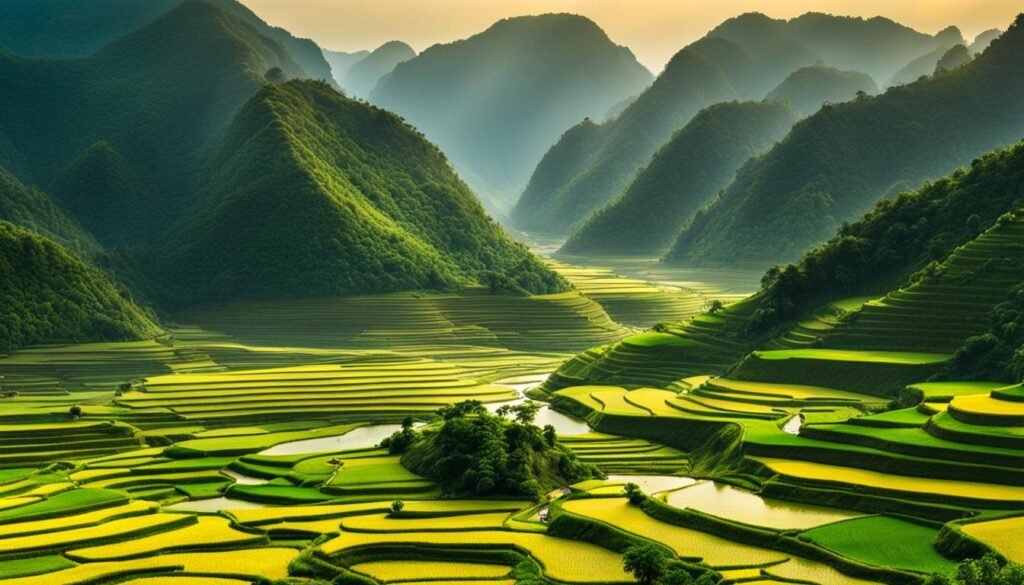
“Vietnam is a country of contrasts, from the bustling cities to the tranquil countryside. The culture and history are fascinating, and the food is simply delicious. It’s a must-see destination for any traveler.”
Conclusion
You have now learned about the diverse cultures and landscapes that make up South East Asia. From Indonesia’s stunning archipelago to Vietnam’s rich history, this region has something for everyone.
As you plan your next trip, consider exploring the member nations of ASEAN or immersing yourself in the unique cultures of Thailand and Indonesia. Whether you prefer the bustling cities or the tranquil beaches, South East Asia offers a tapestry of experiences.
Take some time to research the different countries in the region and decide which ones interest you the most. With its rich history and vibrant present, South East Asia is truly a melting pot of cultures and experiences waiting to be discovered.
FAQ
What countries are in South East Asia?
South East Asia consists of eleven countries: Brunei, Cambodia, Indonesia, Laos, Malaysia, Myanmar, the Philippines, Singapore, Thailand, Timor-Leste, and Vietnam.
What are the diverse cultures found in South East Asia?
South East Asia is a melting pot of cultures, with each country boasting its own unique traditions, languages, and customs. From the vibrant festivals of Thailand to the rich heritage of Vietnam, the region offers a fascinating tapestry of diversity.
What kind of landscapes can be found in South East Asia?
South East Asia is known for its diverse landscapes, ranging from lush rainforests and pristine beaches to towering mountains and bustling cities. Whether you’re seeking adventure in the jungles of Borneo or relaxation on the white sands of Bali, the region has something for everyone.
Which countries are part of the Association of Southeast Asian Nations (ASEAN)?
The member nations of ASEAN are Brunei, Cambodia, Indonesia, Laos, Malaysia, Myanmar, the Philippines, Singapore, Thailand, and Vietnam. These countries collaborate to promote economic growth, regional peace, and cultural cooperation.
What makes Indonesia unique?
Indonesia, the largest country in South East Asia, is known for its breathtaking natural beauty and diverse cultural heritage. With thousands of islands, it offers stunning landscapes, bustling cities, and a rich blend of traditions from different ethnic groups.
What makes Thailand a popular tourist destination?
Thailand, often called “The Land of Smiles,” attracts visitors with its vibrant cities, ancient temples, and mouthwatering cuisine. From the bustling streets of Bangkok to the serene beaches of Phuket, Thailand offers a mix of history, culture, and relaxation.
What is unique about Vietnam?
Vietnam boasts a rich history that dates back centuries, with influences from ancient dynasties and French colonial rule. The country’s cultural traditions, delicious cuisine, and beautiful landscapes make it a captivating destination for travelers.
In conclusion, what makes South East Asia a fascinating region to explore?
South East Asia’s remarkable diversity of cultures and landscapes makes it an enchanting region to discover. From the bustling markets of Malaysia to the ancient temples of Cambodia, this corner of the world offers a captivating blend of history, natural beauty, and cultural richness.

